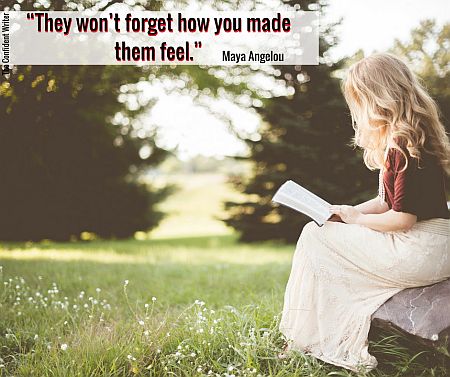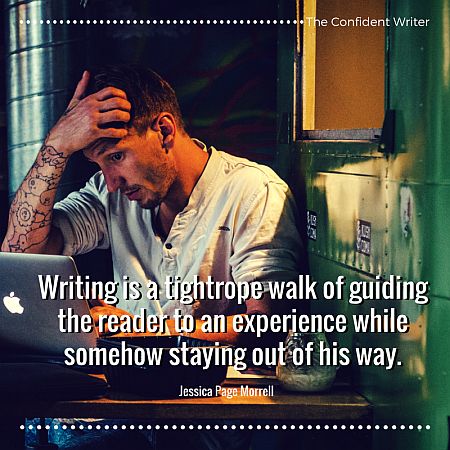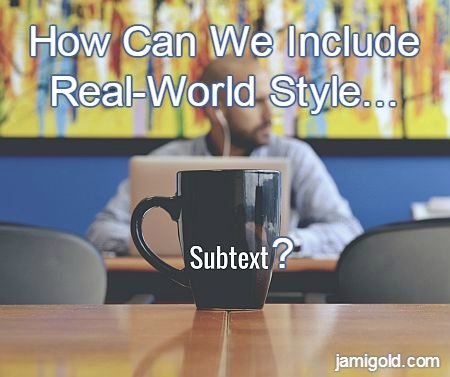We’ve talked many times here before about deep point of view (POV) and how relating the story from inside our character’s head can strengthen our writing. For example, deep POV can:
- solve many of our craft issues, such as showing vs. telling
- smooth the insertion of our character’s thoughts
- evoke emotions in readers
- help us avoid information dumps
- make descriptions more active and vivid
Regular readers of my blog know that I’m also a big fan of subtext, the meanings hiding between our words. I’ve pointed out how subtext…:
- lurks everywhere, including in our plot and characters (even in “comic book” stories)
- can be found in our story’s genre and tropes as well, contributing to readers’ expectations
- gives characters layers
- helps us develop non-POV characters
- gives readers hints about characters
Today, we’re going to bring those two concepts together. We can layer certain hints in the subtext between characters when we write in deep POV, and these techniques develop both the characters involved and the relationship between them.
Filling in for me during NaNoWriMo, Lisa Hall-Wilson is here to share her deep POV insights with us. She’s digging into ways we can replicate the real-life subtext we see around us by layering our writing with action beats and deep POV’s internal dialogue.
Please welcome Lisa Hall-Wilson! *smile*
*****
How Relationships Affects Subtext in Fiction
by Lisa Hall-Wilson
Ever had a conversation where you were outwardly talking about one thing, but were actually talking about something else? That’s subtext and it’s an important technique to learn and apply in fiction, especially if you’re writing in Deep Point of View (POV).
Subtext is the silent conversation that happens while another topic is being discussed. Subtext can use euphemisms and other diversionary tactics to have a private or intimate conversation in public—when we need this to mean that.
Shared Knowledge Affects Dialogue
Take the example below of a mother speaking with her teenage son the morning after he’s missed his curfew:
Mom: Came in pretty late last night.
Son: Yep.
Mom: You promised it wouldn’t happen again.
Son: I know.
Without internal dialogue and some beats, we don’t really know what the subtext of this conversation is. Did the son miss curfew because he pulled an all-nighter at the library studying, and mom is really just concerned for his health? Is the son frequently abusive and this conversation is more of a power struggle — a what are you gonna do about it conversation?
What about the two criminals who have a conversation about a topic that’s understood between them?
Bad Guy #1: You do it?
Bad Guy #2: Yeah.
Bad Guy #1: Any problems?
Bad Guy #2: Nothin’ I couldn’t handle.
Did they just kill someone or take out the trash? Without the subtext, or an understanding of the shared knowledge they’re talking about, there’s no way for an outsider to interpret what they’re really talking about (the outsider in this case could be the cleaning lady, or the law enforcement listening through a wire tap).
Either way, adding layers of meaning for readers behind the dialogue adds some rich texture, conflict, authenticity, and understanding to the story.

Real-World Subtext is Non-Verbal Communication
Convey subtext with expression, tone, posture, gesture, touch, thought, etc. Click To TweetSubtext is conveyed through what Psychology Today called “a silent orchestra,” which is a combination of facial expression, tone of voice, posture, and body language.
Watch the non-verbal communication between two people who know each other well, who share a history, and you’ll realize they have entire conversations without words (think of couples, siblings, or best friends). The better two people know one another, the subtler the communication becomes because of familiarity with facial expressions and attitudes, but also because of a shared history.
Example of Real-World Communication through Shared Knowledge
My younger daughter was a competitive cheerleader for many years, and I would attend as many practices as I was able, but I had to stay in another room behind a pane of glass. When she would complete a difficult stunt or tumbling pass, she would spin to see if I had been watching. I would give a thumbs up and she would beam.
When she fell, she would get up and look at me. I would blink twice. OK? She would blink twice back. I’m OK.
This system was developed over time, through history together. The congratulatory thumbs up was socially acceptable in that setting. Mom asking if she was OK after a fall was less so and required subtler communication.
How Intimacy Affects Subtext
The more characters share experiences, the more subtext we can include. Click To TweetLet’s face it, some silent conversations are not very subtle at all. A husband taps his watch and glares at his wife across the room. That is not subtle at all, but the husband is being blatant on purpose.
Intimacy allows us to make unspoken demands on another’s time or actions. The wife’s response however, could be just as blatant — “Oh, I’m getting the look. Better go. See you tomorrow girls” — or she could simply raise her brows to acknowledge the gesture and turn away. I’m not ready to go yet, be mad if you want to.
This happens ALL the time in real life, so it’s important to capture these small conversations authentically in fiction as well.

The Power of Touch with Subtext
A lot is conveyed by a touch: whether it’s wanted or not, social and historical context, gender, personal history, etc. Deep POV must be tight and economical, so do your best to have every touch pull double duty, whether it’s a sex scene, battle scene, or a business meeting.
Touch with the Subtext of Authority or Power
Touch can be a display of authority or power, think of the teacher who places a hand on the top of the head of the child acting out for instance. A mother holding out a hand is a summons to a small child.
Almost touching can also convey many things. Think about the boss who stands a little too close to his female secretary. There’s a power imbalance here, the subtext is more nuanced.
Being intentionally crowded in a small space can be a power struggle, an intimidation tactic — that’s subtext. The boss who leans in a little too close to the secretary he’s having an affair with might elicit a giggle from her, a blush, a wink. Invading personal space can say a lot without any words at all.
Touch with the Subtext of (Dis)Interest or Threat
What about the boy who doesn’t like the way another guy is looking at his girl at a party? He could blow up and cause a scene, or more likely he’d let the other guy know to back off without using any words. A hand at her waist, a random kiss on the cheek — all while staring at the other guy?
What about the girl who notices the other guy’s attention? Does she smile and keep meeting his glance, or does she touch the guy she’s with, lean into him maybe — grab his hand? Question asked and answered without a word.
Touch can be reassuring and comforting, a polite greeting depending on culture, inviting or intimidating, claiming or denouncing, promising or threatening. But the reader won’t know unless you show them through the silent orchestra of internal dialogue mixed with facial expression, tone of voice, posture, and body language.
Writing subtext effectively will pull your readers into your story and ratchet up the emotional tension.
*****
 Lisa is an award-winning journalist and author, and she LOVES to mentor writers. She’s been a freelance writer for ten years and recently turned to writing fiction full-time.
Lisa is an award-winning journalist and author, and she LOVES to mentor writers. She’s been a freelance writer for ten years and recently turned to writing fiction full-time.
Her passion is to help writers hone their skills and learn advanced storytelling techniques, so look for her blog to go beyond basics and challenge you. Lisa shares tips to encourage your writer journey at The Confident Writer on Facebook.
*****
 Sign up for a free 5 day course on writing emotions in layers! You’ll get an intermediate-level lesson with a practice exercise via email every day for a week to catapult the emotional intensity of your writing to the next level faster than Tigger on a trampoline!
Sign up for a free 5 day course on writing emotions in layers! You’ll get an intermediate-level lesson with a practice exercise via email every day for a week to catapult the emotional intensity of your writing to the next level faster than Tigger on a trampoline!
This short e-course will help you identify emotional triggers, know the difference between primary and secondary emotions, and write the two most common secondary emotions (shame and anger) with more authenticity and impact!
*****
Thank you, Lisa! You’re absolutely right that we see subtext in real-life relationships all the time because of that shared knowledge between people who know each other, and it’s good to think about how we can bring that reality into our fiction.
Revealing our characters and their relationships through these layers is a great way to avoid information dumps. Little exchanges like this are definitely showing and not telling as well. These are just some of the bonus ways that subtext can strengthen our writing.
Hopefully, Lisa’s examples helped explain how we can use this “code” of knowing looks, inside jokes, and layers of meaning in our writing. I know her examples gave me a couple of new ideas to try. *smile*
Do you notice this style of subtext in real-world situations? Can you think of more examples? How much have you seen this technique used in fiction? Does this give you some ideas for including it in your stories? Do you have any questions for Lisa?

